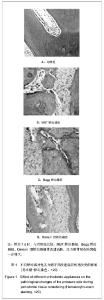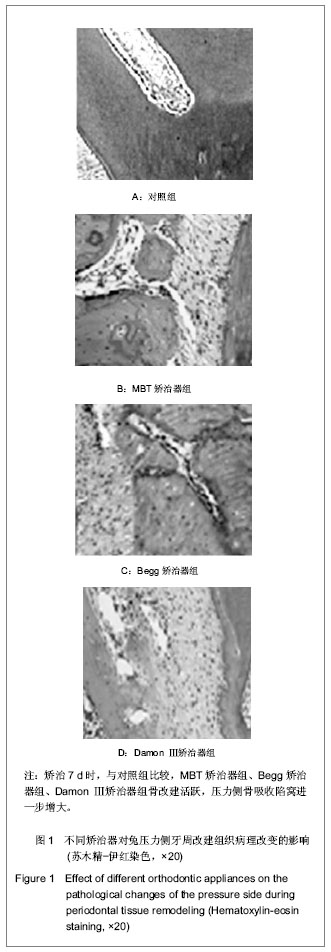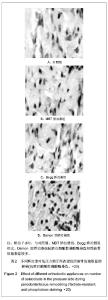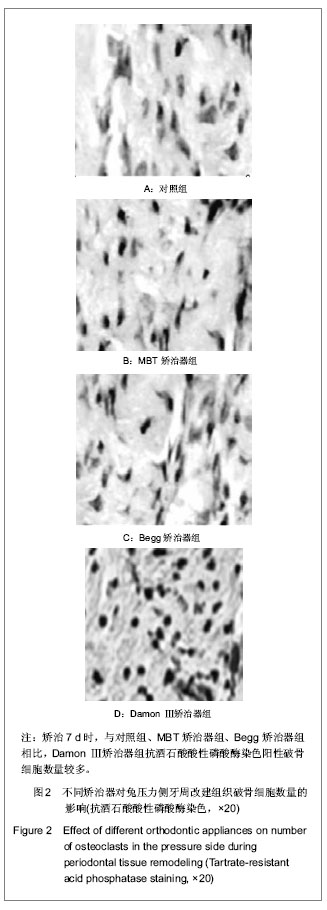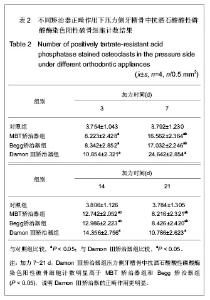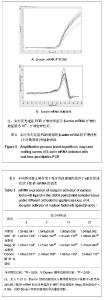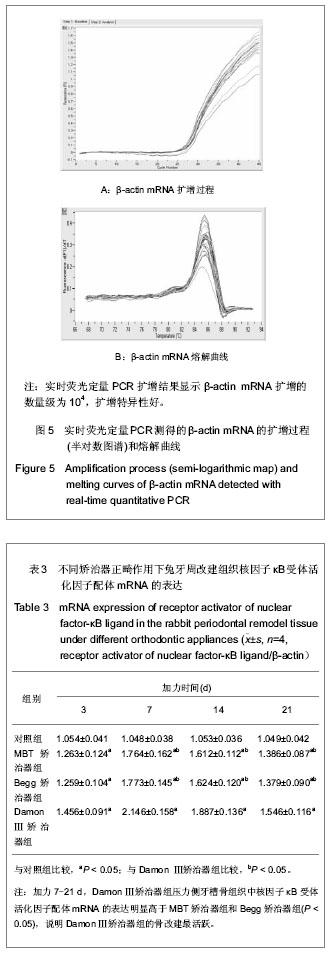Chinese Journal of Tissue Engineering Research ›› 2013, Vol. 17 ›› Issue (20): 3671-3678.doi: 10.3969/j.issn.2095-4344.2013.20.009
Previous Articles Next Articles
Changes of related factors on the pressure side under different appliance orthodontic during periodontal bone remodeling
Ma Yong-ping, Ge Chang-qing, Gao Lin-qing
- Department of Stomatology, Baoding Second Hospital, Baoding 071000, Hebei Province, China
-
Received:2012-10-22Revised:2013-04-07Online:2013-05-14Published:2013-05-14 -
About author:Ma Yong-ping★, Master, Department of Stomatology, Baoding Second Hospital, Baoding 071000, Hebei Province, China zjianj1a1@126.com
CLC Number:
Cite this article
Ma Yong-ping, Ge Chang-qing, Gao Lin-qing. Changes of related factors on the pressure side under different appliance orthodontic during periodontal bone remodeling [J]. Chinese Journal of Tissue Engineering Research, 2013, 17(20): 3671-3678.
share this article
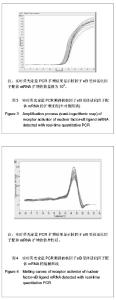
抗酒石酸酸性磷酸酶染色显示阳性细胞可见红色颗粒,定位于胞浆。多核破骨细胞及少部分单核破骨细胞前体为抗酒石酸酸性磷酸酶染色阳性。显微镜下见加压后,压力侧牙槽骨中破骨细胞数量明显增多;矫治7 d时,骨改建活跃,压力侧骨吸收陷窝进一步增大,破骨细胞数量达到高峰,见图2。加力矫治7- 21 d,Damon Ⅲ矫治器组抗酒石酸酸性磷酸酶染色阳性破骨细胞数量明显高于MBT矫治器组和Begg矫治器组(P < 0.05),见表2。 2.4 不同矫治器正畸作用下兔牙周改建组织核因子κB受体活化因子配体mRNA的表达 实时荧光定量PCR检测各目的基因的扩增过程(半对数图谱)和熔解曲线,其中核因子κB受体活化因子配体mRNA扩增过程和熔解曲线见图3,4;β-actin mRNA扩增过程及熔解曲线见图5。 实时荧光定量PCR检测各基因表达水平及变化规律发现,与对照组相比,各试验组压力侧牙槽骨组织中核因子κB受体活化因子配体mRNA的表达均明显增高;其表达在加力后的第3-7天随时间的增加而增加,并于加力后第7天达到最高峰,而后逐渐降低,见表3。加力后第7,14,21天时,Damon Ⅲ矫治器组核因子κB受体活化因子配体mRNA表达高于MBT矫治器组和Begg矫治器组(P < 0.05)。"
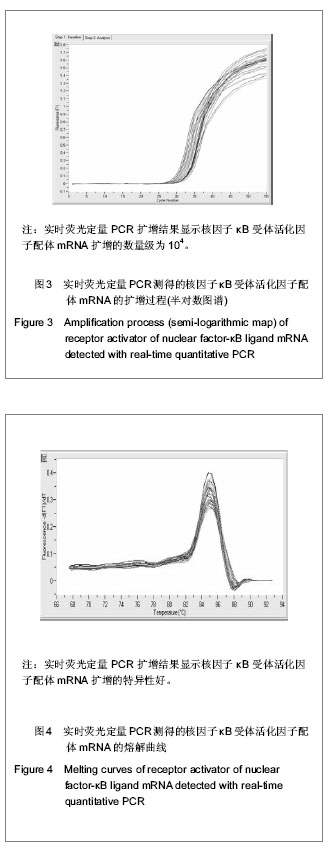
| [1] Ding P, Zhou YH, Liu JX. Kouqiang Zhengjixue. 2006;13(1): 40-43.丁鹏,周彦恒,林久祥.自锁托槽矫治器的发展、分类及特点[J].口腔正畸学,2006,13(1):40-43.[2] He Y, Ma JQ, Zhao HM, et al. Guangdong Yabing Fangzhi. 2010;18(7):370-372.贺钰,马俊青,赵红梅,等.Forsus和Dynamax矫治器对下颌骨生长改形的效果比较[J].广东牙病防治,2010,18(7): 370-372.[3] Zhang XY, Jian XC. Guangdong Yabing Fangzhi. 2010;18(10): 524-527.张新宇,翦新春.自攻型微螺钉远中移动下颌磨牙的临床运用[J].广东牙病防治, 2010,18(10):524-527.[4] Zhang ZY, Li YR, Huang T. Guoji Kouqiang Yixue Zazhi. 2010; 37(2):141-145.张子扬,李玉如,黄统.拔除磨牙矫治安氏Ⅱ类错牙合畸形患者的临床回顾性研究[J].国际口腔医学杂志,2010,37(2):141-145.[5] Na B, Bai XQ, Liu XH. Guoji Kouqiang Yixue Zazhi. 2009; 36(3):281-284.那宾,白雪芹,刘学恒. Damon-Ⅲ矫治器治疗安氏Ⅱ类1分类错颌畸形患者硬组织变化的研究[J].国际口腔医学杂志,2009,36(3): 281-284.[6] Zhu HM, Liu D, Zhang T. Kouqiang Yixue Yanjiu. 2012;28(4): 370-372.朱红明,刘丹,章婷.拔除下颌磨牙矫治安氏Ⅲ类错牙合关系的临床分析[J].口腔医学研究,2012,28(4):370-372.[7] Zhou XR. Beijing Kouqiang Yixue. 2009;17(4):235-236.周欣荣.自锁托槽矫治技术研究进展[J].北京口腔医学,2009, 17(4):235-236.[8] Niu BP. Shiyong Kouqiang Yixue Zazhi. 2008;24(4):608-611.牛白平.全新的正畸概念——Damon系统第一部分Damon系统的基本特点[J].实用口腔医学杂志,2008,24(4):608-611.[9] Belibasakis GN, Bostanci N, Hashim A, et al. Regulation of RANKL and OPG gene expression in human gingival fibroblasts and periodontal ligament cells by Porphyromonas gingivalis: a putative role of the Arg-gingipains. Microb Pathog. 2007;43(1):46-53.[10] Napimoga MH, Benatti BB, Lima FO, et al. Cannabidiol decreases bone resorption by inhibiting RANK/RANKL expression and pro-inflammatory cytokines during experimental periodontitis in rats. Int Immunopharmacol. 2009;9(2):216-222.[11] Irie K, Ekuni D, Yamamoto T, et al. A single application of hydrogen sulphide induces a transient osteoclast differentiation with RANKL expression in the rat model. Arch Oral Biol. 2009;54(8):723-729.[12] Han G, Chen Y, Hou J, et al. Effects of simvastatin on relapse and remodeling of periodontal tissues after tooth movement in rats. Am J Orthod Dentofacial Orthop. 2010;138(5):550.e1-7.[13] Yang PK. Shanxi Yike Daxue Xuebao. 2012;43(8): 586-588.杨朋康.心房颤动患者血浆骨保护素、核因子κB受体活化因子配体水平及临床意义[J].山西医科大学学报,2012,43(8): 586-588.[14] Liu L, Xiong LF, Sun L, et al. Huaxi Kouqiang Yixue Zazhi. 2012; 30(2):119-122,127.刘蕾,熊利峰,孙磊,等.渐进性咬合紊乱对大鼠髁突软骨中护骨素及核因子-κB受体活化因子配体表达的影响[J].华西口腔医学杂志,2012,30(2):119-122,127.[15] Zhou PX, Hu JA, Meng XY. Huaxi Kouqiang Yixue Zazhi. 2012; 30(5):518-521.周平秀,胡济安,孟祥勇.核因子κB受体活化因子配体联合巨噬细胞集落刺激因子诱导破骨细胞分化过程中的蛋白—蛋白相互作用网络的研究[J].华西口腔医学杂志,2012,30(5):518-521.[16] Ge ZL, Yang CX, Lu JJ, et al. Zhongguo Zuzhi Gongcheng Yanjiu yu Linchuang Kangfu. 2011;15(20):3733-3736.葛振林,杨彩霞,卢嘉静,等.犬切牙压低移动过程中牙周组织骨保护素/核因子κB受体活化因子配体的表达[J].中国组织工程研究与临床康复,2011,15(20):3733-3736.[17] Chen SS, Greenlee GM, Kim JE,et al. Editor's Comment and Q&A: Systematic review of self-ligating brackets. American Journal of Orthodontics and Dentofacial Orthopedics. 2010; 137(6):726-727.[18] Reddi D, Bostanci N, Hashim A, et al. Porphyromonas gingivalis regulates the RANKL-OPG system in bone marrow stromal cells. Microbes Infect. 2008;10(14-15):1459-1468.[19] Otsuka T, Kasai H, Yamaguchi K, et al. Enamel matrix derivative promotes osteoclast cell formation by RANKL production in mouse marrow cultures. J Dent. 2005;33(9): 749-755.[20] Mogi M, Otogoto J. Expression of cathepsin-K in gingival crevicular fluid of patients with periodontitis. Arch Oral Biol. 2007;52(9):894-898.[21] Zhu J, Dong CZ, Hu YY, et al. Anhui Yike Daxue Xuebao. 2010;45(5):618-620.祝捷,董崇周,胡圆圆,等.RANKL联合M-CSF体外诱导人外周血单个核细胞成为破骨样细胞的研究[J].安徽医科大学学报,2010, 45(5):618-620.[22] Zhang L, Sun LL, Ding Y, et al. Yati Yasui Yazhoubing Xue Zazhi. 2012(8):440-444,457.张兰,孙琳琳,丁岩,等.IL-1β对人牙周膜成纤维细胞OPG、RANKL mRNA表达的影响[J].牙体牙髓牙周病学杂志,2012 (8):440-444,457.[23] Zhu JX, Zhang G, Wu X, et al. Disan Junyi Daxue Xuebao. 2012;34(4):320-323.祝金香,张纲,武曦,等.RANKL/OPG在高原低氧条件下兔牙周炎发病机制中的作用[J].第三军医大学学报,2012,34(4):320-323.[24] Xiao PP, Chen JM, Ye DF. Zhongguo Yaolixue Tongbao. 2011; 27(10):1392-1396.肖萍萍,陈君敏,叶德富.唑来膦酸对多发性骨髓瘤成骨细胞增殖及其RANKL/OPG表达的影响[J].中国药理学通报,2011,27(10): 1392-1396.[25] Liu LL, Dong FS, Ma WS, et al. Xiandai Kouqiang Yixue Zazhi. 2012(1):25-29.刘丽丽,董福生,马文盛,等.犬牙周膜牵张快速移动牙压力侧牙周组织中RANKL和OPG表达的研究[J].现代口腔医学杂志,2012 (1):25-29. [26] Ristic M, Vlahovic Svabic M, Sasic M, et al. Clinical and microbiological effects of fixed orthodontic appliances on periodontal tissues in adolescents. Orthod Craniofac Res. 2007;10(4):187-195.[27] Yi HW, Lin N, Guan J, et al. Shanghai Kouqiang Yixue. 2012; 21(2):194-198.尹翰文,林娜,关键,等. 双侧下颌支矢状劈开坚固内固定的三维有限元分析[J].上海口腔医学,2012,21(2):194-198.[28] Erkmen E, Sim?ek B, Yücel E, et al. Comparison of different fixation methods following sagittal split ramus osteotomies using three-dimensional finite elements analysis. Part 1: advancement surgery-posterior loading. Int J Oral Maxillofac Surg. 2005;34(5):551-558.[29] Reicheneder CA, Gedrange T, Lange A, et al. Shear and tensile bond strength comparison of various contemporary orthodontic adhesive systems: an in-vitro study. Am J Orthod Dentofacial Orthop. 2009;135(4):422-423.[30] Wittrant Y, Theoleyre S, Couillaud S, et al. Regulation of osteoclast protease expression by RANKL. Biochem Biophys Res Commun. 2003;310(3):774-778.[31] Wang W, Liu Y, Wang BK. Beijing Kouqiang Yixue. 2009; 17(2):72-75.王威,刘郁,王邦康.大鼠正畸压力侧牙槽骨改建中RANKL和OPG mRNA的表达[J].北京口腔医学,2009,17(2):72-75.[32] Kawasaki K, Takahashi T, Yamaguchi M, et al. Effects of aging on RANKL and OPG levels in gingival crevicular fluid during orthodontic tooth movement. Orthod Craniofac Res. 2006;9(3):137-142.[33] Ahrari F, Ramazanzadeh BA, Sabzevari B, et al. The effect of fluoride exposure on the load-deflection properties of superelastic nickel-titanium-based orthodontic archwires. Aust Orthod J. 2012;28(1):72-79.[34] Major TW, Carey JP, Nobes DS, et al. Deformation and warping of the bracket slot in select self-ligating orthodontic brackets due to an applied third order torque. J Orthod. 2012; 39(1):25-33.[35] Liu X, Yao S, Zhou Z, et al. The effects of orthodontic treatment on the morphology of temporomandibular joint of the adult with the low angle Class II malocclusions: a CT study. Hua Xi Kou Qiang Yi Xue Za Zhi. 2012;30(1):45-48.[36] Cattaneo PM, Treccani M, Carlsson K, et al. Transversal maxillary dento-alveolar changes in patients treated with active and passive self-ligating brackets: a randomized clinical trial using CBCT-scans and digital models. Orthod Craniofac Res. 2011;14(4):222-233.[37] Major TW, Carey JP, Nobes DS, et al. Measurement of plastic and elastic deformation due to third-order torque in self-ligated orthodontic brackets. Am J Orthod Dentofacial Orthop. 2011;140(3):326-339.[38] Major TW, Carey JP, Nobes DS, et al. An investigation into the mechanical characteristics of select self-ligated brackets at a series of clinically relevant maximum torquing angles: loading and unloading curves and bracket deformation. Eur J Orthod. In press.[39] Vajaria R, BeGole E, Kusnoto B, et al. Evaluation of incisor position and dental transverse dimensional changes using the Damon system. Angle Orthod. 2011;81(4):647-652.[40] Sifakakis I, Pandis N, Makou M, et al. A comparative assessment of the forces and moments generated at the maxillary incisors between conventional and self-ligating brackets using a reverse curve of Spee NiTi archwire. Aust Orthod J. 2010;26(2):127-133. |
| [1] | Jiang Hongying, Zhu Liang, Yu Xi, Huang Jing, Xiang Xiaona, Lan Zhengyan, He Hongchen. Effect of platelet-rich plasma on pressure ulcers after spinal cord injury [J]. Chinese Journal of Tissue Engineering Research, 2021, 25(8): 1149-1153. |
| [2] | Liu Zhichao, Zhang Fan, Sun Qi, Kang Xiaole, Yuan Qiaomei, Liu Genzhe, Chen Jiang. Morphology and activity of human nucleus pulposus cells under different hydrostatic pressures [J]. Chinese Journal of Tissue Engineering Research, 2021, 25(8): 1172-1176. |
| [3] | Li Quanxi, Shen Yu, Wan Wei, Sun Shanzhi. Changes of abdominal wall mechanics and pain after tension-free inguinal hernia repair with polypropylene mesh [J]. Chinese Journal of Tissue Engineering Research, 2021, 25(4): 548-552. |
| [4] | Yang Caihui, Liu Qicheng, Dong Ming, Wang Lina, Zuo Meina, Lu Ying, Niu Weidong. Serine/threonine protein kinases can promote bone destruction in mouse models of chronic periapical periodontitis [J]. Chinese Journal of Tissue Engineering Research, 2021, 25(23): 3654-3659. |
| [5] | Huo Hua, Cheng Yuting, Zhou Qian, Qi Yuhan, Wu Chao, Shi Qianhui, Yang Tongjing, Liao Jian, Hong Wei. Effects of drug coating on implant surface on the osseointegration [J]. Chinese Journal of Tissue Engineering Research, 2021, 25(22): 3558-3564. |
| [6] | Jiang Hai, Yu Yu, Liu Zhicheng, Zhang Qiliang. Treatment of plantar fasciitis with extracorporeal shock wave and corticosteroid injection: comparison of plantar pressure and gait [J]. Chinese Journal of Tissue Engineering Research, 2021, 25(21): 3286-3291. |
| [7] | Jiang Shengyuan, Li Dan, Jiang Jianhao, Shang-you Yang, Yang Shuye. Biological response of Co2+ to preosteoblasts during aseptic loosening of the prosthesis [J]. Chinese Journal of Tissue Engineering Research, 2021, 25(21): 3292-3299. |
| [8] | Li Yuanyuan, Lu Yingjuan, Ye Yushan, Mustafa M.M Weldali, Chang Shaohai. Constructing finite element models of three maxillary arch forms [J]. Chinese Journal of Tissue Engineering Research, 2021, 25(20): 3125-3129. |
| [9] | Bai Xiaotian, Huo Hongfeng. Biomechanical evaluation of foot and ankle function: constructing static and dynamic indexes of the foot [J]. Chinese Journal of Tissue Engineering Research, 2021, 25(17): 2747-2754. |
| [10] | Lin Qinqin, Li Ruoming, Geng Yuanwen, Yuan Hang, Yang Xiaoli. Characteristics and changes of plantar pressure of healthy men aged 3-35 years old during natural walking [J]. Chinese Journal of Tissue Engineering Research, 2021, 25(15): 2315-2320. |
| [11] | Wu Yukun, Han Jie, Wen Shuaibo. Mechanism of Runx2 gene in fracture healing [J]. Chinese Journal of Tissue Engineering Research, 2021, 25(14): 2274-2279. |
| [12] | Nie Jing, Shi Xiaoyu. Cone-beam CT measurement of alveolar bone thickness of the maxillary anterior area at implant anchorage site in different sexes [J]. Chinese Journal of Tissue Engineering Research, 2021, 25(14): 2133-2136. |
| [13] | Zhang Chuanhui, Li Jianjun, Yang Jun. Effects of dynamic pressure on the proliferation and mechanical properties of rabbit adipose mesenchymal stem cells transfected with insulin-like growth factor-1 [J]. Chinese Journal of Tissue Engineering Research, 2021, 25(13): 1982-1987. |
| [14] | Jia Wei, Zhang Mandong, Chen Weiyi, Wang Chenyan, Guo Yuan. Effects of femoral prosthetic materials on artificial knee arthroplasty performance [J]. Chinese Journal of Tissue Engineering Research, 2021, 25(10): 1477-1481. |
| [15] | Liu Jie, Fan Ruoxun, Gao Jiazi, Zeng Sheng, Liu Jun. Mechanical responses of the degenerated lumbar spines with different degrees at low frequency vibration generated by vehicle driving using finite element analysis [J]. Chinese Journal of Tissue Engineering Research, 2020, 24(9): 1371-1377. |
| Viewed | ||||||
|
Full text |
|
|||||
|
Abstract |
|
|||||
